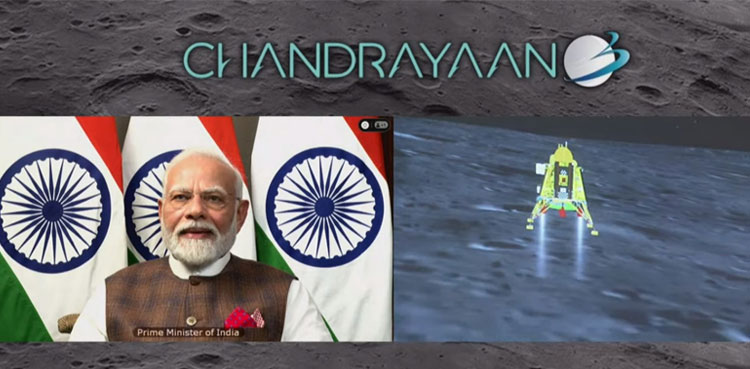
India has landed its Chandrayaan-3 spacecraft on the moon’s south pole, becoming only the fourth nation ever to accomplish such a feat. With the swift landing, India also became the first nation in the world to reach the moon’s south pole.
“This is a victory cry of a new India,” said Prime Minister Narendra Modi, who was seen waving the Indian flag as he watched the landing from South Africa, where he is attending the BRICS summit.
Scientists and officials clapped, cheered and hugged each other as the spacecraft landed and as the government now looks to spur investment in private space launches and related satellite-based businesses.
“India is on the moon,” said S. Somanath, chief of the Indian Space Research Organisation (ISRO) as the Chandrayaan-3 spacecraft landed on the lunar south pole.
This was India’s second attempt to land a spacecraft on the moon and comes less than a week after Russia’s Luna-25 mission failed. People across the country were glued to television screens and said prayers as the spacecraft approached the surface.
WHAT IS INDIA’S CHANDRAYAAN-3 MISSION?
The Chandrayaan-3 is aimed at the lunar south pole, a region with water ice, or frozen water, that could be a source of oxygen, fuel and water for future moon missions or a more permanent moon colony.
If it lands successfully, the Chandrayaan-3 is expected to remain functional for two weeks, running a series of experiments including a spectrometer analysis of the mineral composition of the lunar surface.
The Chandrayaan-3 lander stands about 2 meters tall and has a mass of just over 1,700 kg (3,747.86 lb), roughly on par with an SUV. It is designed to deploy a smaller, 26-kg lunar rover.
NASA administrator Bill Nelson told Reuters that the U.S. space agency was “looking forward” to what would be learned from the Indian mission.
WHEN DID IT LAUNCH?
The Chandrayaan-3 mission was launched on July 14 from India’s main space port in the southern state of Andhra Pradesh.
Since then, it has looped through progressively wider-ranging orbits of Earth, transferred to a lunar orbit and emerged as a focus of national pride and global interest after Russia’s failed attempt to beat it to a landing on the moon’s south pole.
WHAT HAPPENED TO ISRO’S EARLIER MOON LANDING ATTEMPT?
India’s previous attempt to land on the lunar south pole failed in 2019.
Chandrayaan-2 successfully deployed an orbiter but its lander and rover were destroyed in a crash near where Chandrayaan-3 will attempt a touchdown.
Rough terrain is one of the complications for a south pole landing. ISRO scientists say they have made adjustments that make it more likely the current mission will land successfully. That includes a system to broaden the potential landing zone. The lander has also been equipped with more fuel and sturdier legs for impact.
Russia’s first moon mission in 47 years failed over the weekend when its Luna-25 spacecraft crashed into the moon.
A private Japanese space startup, ispace (9348.T), failed an attempted lunar landing in April.
View this post on Instagram
https://ift.tt/SZ3ra0L
https://ift.tt/IsQexd1





0 Comments